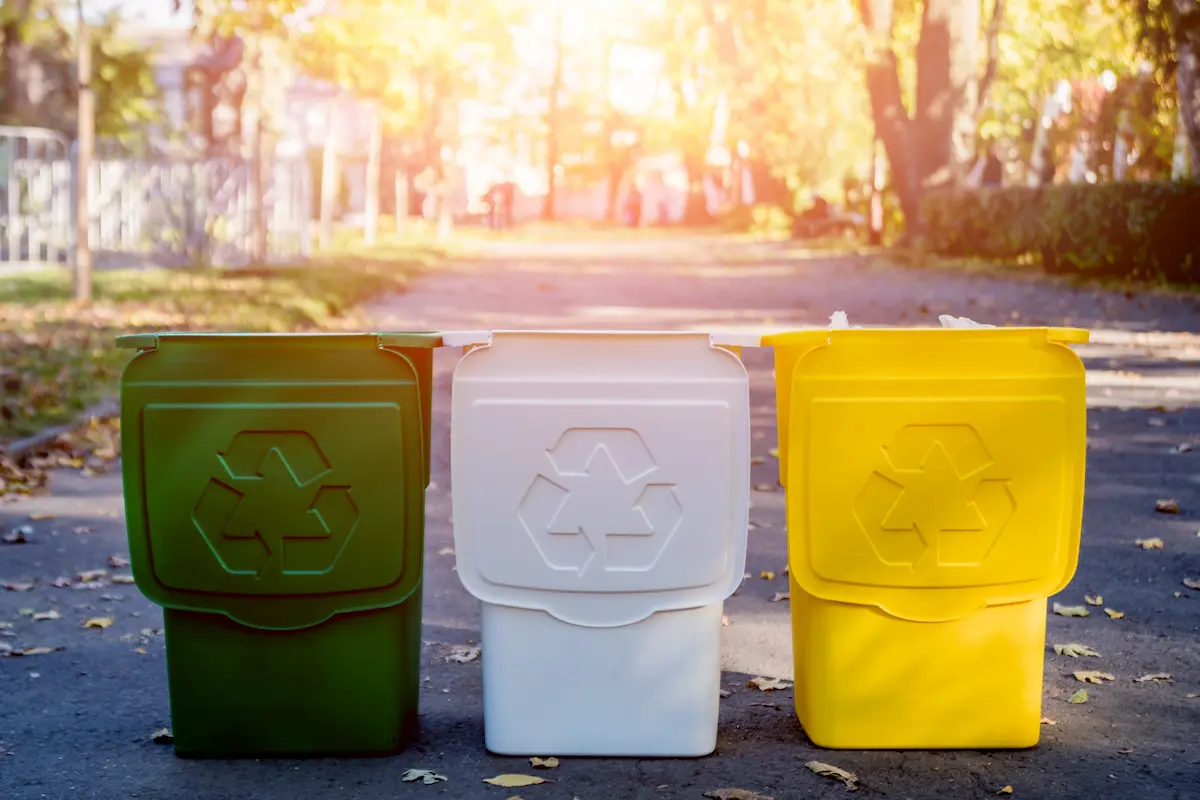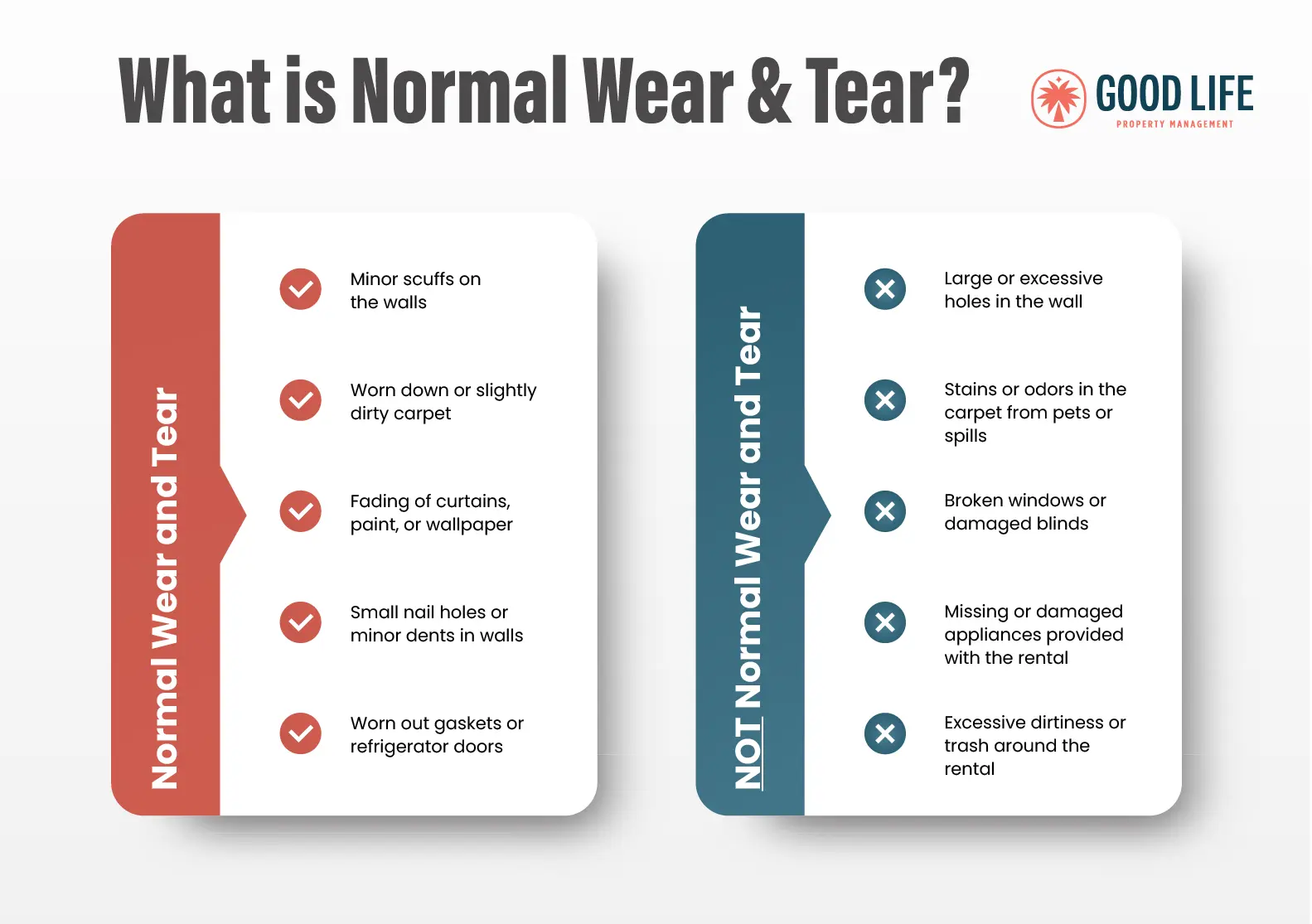Common Questions About Security Deposits in California
Updated: October 31, 2024
Landlords often aren’t sure what they can charge vacating tenants for. We’re here to answer the most common questions we get about security deposits.
If you’ve ever rented an apartment or a house, you’ve probably had to put down a security deposit. This deposit is put down to cover any excessive damage that may occur to the property during tenancy, from paint chipping to carpet cleaning.
However, many property owners aren’t exactly sure what they can charge for. The term “normal wear and tear” gets thrown around a lot in this industry. It’s important to know what things like this mean and how it affects you, your home, and your tenants.
At Good Life, we get questions relating to these deposits every week. We know that the process can be confusing and difficult to navigate, especially when you aren’t familiar with the laws. Luckily for you, we’re here to tell you everything you need to know about security deposits.
Table of Contents
- What is a security deposit?
- How do security deposits work?
- How much should a security deposit be?
- What can I use the security deposit for?
- What is considered normal wear and tear?
- What is useful life?
- How do I inform the tenant of their charges?
- What if the work can’t be completed within 21 days?
- Can I charge a pet deposit, too?
- California laws on security deposits
What is a security deposit?
Definition of Security Deposit
A security deposit is an upfront payment made by a tenant to a landlord. Its primary purpose is to cover any excessive damage that might occur during tenancy, beyond normal wear and tear.
Pet deposits and security deposits are not the same thing. In order to learn about pet deposits, read our section on pet deposits below.
How do security deposits work?
How much should a security deposit be?
Governor Newsom recently signed Assembly Bill 12 (AB12) into law, which limits how much landlords can charge for a security deposit. As of July 2024, you cannot charge more than one month’s rent for a security deposit. Previously, landlords were able to collect two months’ rent for unfurnished properties and three months for furnished rentals.
Typically, landlords across the U.S. charge the equivalent of one month’s rent as a security deposit. While in the past this was just a general rule of thumb, it’s now state law in California that you cannot charge more than one month’s rent for a security deposit.
While the aim of AB12 is to standardize the security deposit process across different types of rentals and alleviate potential financial burdens for tenants, there have been some unintended consequences that negatively impact renters.
The limit on security deposit has forced many housing providers to eliminate their conditional approval programs. These programs allow for slightly higher deposits for applicants that pose a marginal credit risk. Tenants with lower credit or income will have a more challenging time getting approved for housing because of the elimination of conditional approval programs.
What can I use the security deposit for?
In California, landlords are granted the right to use the security deposit for specific reasons. These guidelines ensure that the tenants’ rights are protected while allowing landlords to maintain the integrity and quality of their property.
- Unpaid Rent: Landlords can utilize the deposit to cover any unpaid rent once the lease has ended. This ensures that they’re not left at a financial disadvantage due to non-payment.
- Cleaning Fees: If the property requires cleaning beyond what’s deemed “normal wear and tear,” the deposit can be used to cover these costs. The goal is to restore the property to its pre-move in condition.
- Repairs: Damages that surpass the regular wear and tear can be repaired using the deposit. This doesn’t include issues that arise from daily living but focuses on negligent, careless, or abusive living habits of the tenant.
- Replacing Personal Property: If items provided as part of the rental agreement, like appliances or furniture, are damaged or lost, the deposit can be used to replace them.
Normal Wear and Tear
* Click the image to enlarge it *
What is considered normal wear and tear in a rental?
Normal wear and tear is the expected deterioration of a property over time due to regular use. Think of things like faded paint from sunlight exposure, carpet wearing down from foot traffic, or door handles loosening a bit. The key to telling wear and tear apart from actual damage is the cause.
If something deteriorates because of time and regular use, it’s wear and tear. But if it’s due to negligence or misuse, like a hole in the wall or a broken window, then it’s damage. This can include, but it is not limited to, hardwood floor scratches, drawings on walls, chips in tile/glass, and carpet stains. Costs for such damages can be deducted from the security deposit. If the expenses exceed the deposit amount, the tenant can be billed for the additional costs.
If needed, the security deposit can be used for either unpaid rent and/or cleaning charges. These cleaning charges would be used in order to bring the property back to the condition it was at prior to move in.
However, as time progresses, the understanding of what constitutes wear and tear might evolve.
Example - What is normal wear and tear after 5 years?
Example - What is normal wear and tear after 10 years?
What is useful life?
Useful life determines when a part of the home, such as carpet or paint, needs to be redone entirely. Even a great paint job only lasts a few years and this alters how much you should charge your tenants.
The expected life for paint is usually 3 years, depending on the property. At Good Life, we charge tenants that have been at the property for one year ⅔ of the paint cost. If one wall costs $100 to repaint, the tenant is charged $66.
There is no set law regarding the calculations, but going on a 3-year life for paint is fairly standard throughout the industry. Apartment complexes sometimes do a 2-year life, i.e. a one year tenant is charged $50 for the $100 wall. For more information on the life of other features in the home, check out this Fit Small Business article on normal wear and tear for rental properties.
How do I inform the tenant of their charges?
Once the property has been assessed and repairs have been made, you will need to send an invoice to the former tenant. If the charges exceed $125, an itemized receipt needs to be given with invoices from the contractors used. This will show a breakdown of everything that was charged and why.
It’s best to take photos of the apartment before the tenant moves in and after they leave. That way, if the tenant asks where the carpet is damaged, you have evidence to back you up.
Within 21 days of move out, you need to send the tenant the remaining (or full) deposit with the invoice and explanation of charges. Without this, you could wind up having to return the funds or go to small claims court.
What if the work can't be completed within 21 days?
If the necessary repairs cannot be completed within the 21 days, you may provide the tenant with a good faith estimate. This is a rough breakdown of the expected repairs and costs along with the expected refund of the deposit.
Once the work has been completed, you must notify them within 14 days and adjust the return amount if needed.
Can I charge a pet deposit, too?
A pet deposit can be charged to cover damage expected from a pet living in the home. It is best to add this to the total deposit you are charging, rather then calling it a separate pet deposit. The reasoning for this is because if you call it a pet deposit, you can only use it for pet-related damage. For example, if you plan to charge a security deposit of $1,000, then they inform you that they have a pet, you would add the additional deposit to the $1,000. Pet deposits usually are usually between $200-$500.
A pet deposit plus security deposit cannot exceed the rules outlined above. For example, if you want to charge them an extra $500 deposit for a pet, this can’t be more than one month’s rent.
Also, keep in mind that pets and service animals are not the same thing. You cannot charge rent for service animals. To learn more about service animals laws, check out our blog.
Security Deposit California law
California’s Governor, Gavin Newsom, has signed Assembly Bill 12, setting a cap on security deposits at one month’s rent. This new legislation, which takes effect on July 1, 2024, aims to make housing more affordable.
Previously, landlords could demand up to three months’ rent for security deposits, resulting in high upfront costs for renters, especially in cities like Los Angeles and San Francisco where median rents are high.
Normal Wear and Tear California
In California, “normal wear and tear” refers to the inevitable physical deterioration that happens over time with regular use of a rental property, even with tenants who are careful and responsible. It’s expected that a rental property will not look exactly the same after a tenant moves out as when they moved in, due to the typical effects of aging and everyday living.
Examples of normal wear and tear in California might include:
- Fading of curtains, paint, or wallpaper due to sunlight exposure.
- Minor scuffs or marks on the walls.
- Naturally worn down or slightly dirty carpet (not deep stains or soiling).
- Small nail holes or minor dents in the walls from picture hangings.
- Doors sticking due to humidity.
- Faded paint or wallpaper.
- Worn-out gaskets on refrigerator doors.
- Loose hinges or handles on doors or cabinets.
On the other hand, damage caused by carelessness, misuse, or abuse by the tenant or their guests is not considered “normal wear and tear.” This could include things like:
- Large or excessive holes in walls.
- Stains or odors in the carpet from pets or spills.
- Broken windows or damaged blinds.
- Missing or damaged appliances provided with the rental.
Security Deposit return California
In California, the laws governing the collection, maintenance, and return of security deposits can be found in the California Civil Code Section 1950.5. This section lays out the specifics on how landlords should handle security deposits. Here are some of the key provisions from the code:
Maximum Amount:
Landlords can charge a maximum of one month’s rent as a security deposit.
Senate Bill 644 (SB644):
Assembly Bill 2801:
Assembly Bill 2801 (AB2801) is a new bill that will come into effect on July 1, 2025. This bill outlines new requirements for handling security deposits to ensure landlords and property managers are adhering to fair practices from Housing Providers.
The three main elements of AB2801 that all California landlords should be aware of are:
- You are legally required to take before-and-after photos of your property. Your move-in/move-out checklist must be accompanied by detailed photographs of the property.
- You cannot charge an automatic cleaning fee for anything from carpets to the whole rental. Landlords are only able to charge cleaning fees when needed to restore the property to its original condition.
- If a tenant requests a pre-move-out inspection, you are required to perform one and deliver an itemized list of any damage found during the inspection. You can only deduct items on that list from the security deposit.
Permissible Uses of Security Deposit:
Landlords can use the deposit for:
- Unpaid rent.
- Cleaning the rental unit to the condition it was in at the beginning of the tenancy.
- Repair of damages, other than normal wear and tear, caused by the tenant or the tenant’s guests.
- If the lease or rental agreement allows it, for the restoration of or replacing property (like keys), excluding ordinary wear and tear.
Returning the Deposit:
landlords have 21 days after the tenant has vacated the premises to either
- Return the entire security deposit to the tenant.
- Send a partial refund and an itemized statement of each deduction, including receipts for materials and labor. If certain repairs can’t be done within the 21-day period, the landlord can send an estimate of the costs, and then must send the receipts within 14 days of the repairs being completed.
Bad Faith Retention:
Interest on Security Deposits:
Normal Wear and Tear:
What happens if a landlord does not return the security deposit in 21 days California?
In California, when a landlord neglects to return the security deposit or provide an itemized statement of deductions within the stipulated 21 days after the tenant vacates the property, several repercussions come into play.
Firstly, the landlord might lose the right to retain any part of the security deposit, meaning the tenant could be entitled to a full refund.
Moreover, if the landlord is determined to have withheld the deposit in “bad faith”—that is, with intentional non-compliance or without a legitimate reason—the tenant has the right to sue for up to double the amount of the deposit withheld.
Final Thoughts
If you found this article helpful, follow us on social media. We post daily tips to help you manage your own rental property:
Steve Welty
Subscribe to our Weekly Newsletter
Join the 5k+ homeowners receiving Local Law Updates and Landlord Tips. Delivered to your inbox every Saturday at 6am PST.
Share this:
Get in touch with us:
We make owning rental property easy.
Choose Your Next Step
Good Life Blogs
We believe that education is empowering.

SB 52: California May Ban AI Rent Pricing Tools
California’s SB 52 could ban landlords from using AI to set rent prices. Learn how this bill may impact your rental business and what actions you can take.

Trash Collection Fees Coming to San Diego Rental Properties
Trash collection fees are coming to San Diego landlords. Learn who’s affected, how much it will cost, and how to stay compliant.

How to Turn Vacant Rental Properties into Tax Deductions
Learn how to turn your rental property’s vacancy into potential tax deductions. Discover the rules, strategies, and tips landlords need to know.








